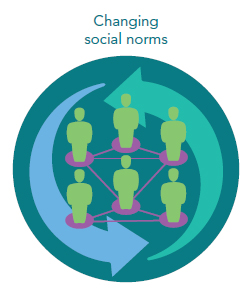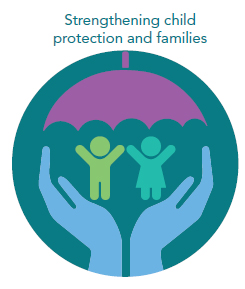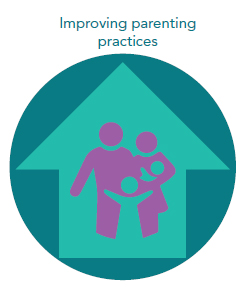Programmes, research, and policies on VAW and VAC have historically been siloed without consideration for the intersecting nature of these forms of violence. There is an emerging global call to consider the intersections of VAC and VAW within families and across the lifespan within programming to effectively prevent and reduce violence experienced by women and children in the home. Through a review of violence prevention programmes in the Africa region, four key strategies have been identified to address the intersections of VAW and VAC to reduce the life-long and intergenerational consequences. (1) Economic strengthening interventions targeting women and girls have been proposed as promising to reduce both VAW and VAC (2), but as a strategy it has not been shown to effective on its own and is being explored in combination with other strategies.(3)

-
Changing social norms and reducing the culture of violence
Promising interventions incorporate elements of community mobilisation – in Uganda, activism and action at the community level was combined to address power imbalances between men and women. This programme was also adapted for Rwanda, and evidence has shown that this intervention has the potential to shift gender norms and attitudes. These positive changes in gender norms have been attributed to community diffusion and inclusion of the “whole community”, not only those identified as high risk. Qualitative interviews in Uganda found an improvement in parent-child relationships, with a reduction in corporal punishment.(4)
-
Strengthening child protection and response to exposure to violence
A psychosocial intervention in Zambia has been found to be effective in reducing women’s experience of IPV by reducing harmful alcohol use between couples.(5) This approach introduced a task-shifting model through the use of trained community-based workers to deliver a combination of treatments for a range of mental health issues. There is the potential to improve outcomes for children in violent households through the inclusion of a child component. It was also found that a multi-component intervention in Burkino-Faso which combines economic and family strengthening approaches has the potential to improve child protection outcomes in the context of severe poverty. This intervention improved marital relationships and reduced emotional violence by a partner, while mothers also reported that they were less likely to use harsh discipline methods and showed a better quality of child–parent relationships.(2) Similarly, a family strengthening programme was delivered to families living in poverty who were part of the government cash transfer programme for children in Rwanda.(3) This study found that active coaching, play, alternatives to harsh discipline and violence, and encouragement of family strengths created a better care environment for young children and a reduction of harsh discipline.
-
Improving Parenting Practices
A focus on improving parenting practices holds promise for preventing harsh parenting practices and shifting gender norms. A South African programme has been shown to increase positive parenting and reduce harsh parenting and conduct problems in children, but the long-term impact is still to be established.(6, 7) A multi-component intervention in Uganda included a parenting intervention targeting young men, combined with community mobilisation. A father-centred parenting programme combined with a mentorship component and community mobilisation has shown promise for reducing physical child punishment as well as transforming gender norms and reducing IPV.(8)
-
Adolescence as a period of risk
Adolescence has been identified as a period of both a high risk of victimisation and perpetration of both forms of violence, and a time in which social norms are entrenched. Targeting this risk period has predominantly been approached through school-based interventions. In South Africa, a multi-faceted intervention that includes school strengthening components for learners and educators as well as a family strengthening component showed promise for reducing dating and sexual violence. A Kenyan school-based programme focusing on gender inequality and promoting positive masculinities among boys and skills development in girls has shown a reduction of sexual assault among female adolescents. Through the skills-based training, empowerment, and transforming social norms, targeted adolescents are able to strengthen the protective factors that lead to a reduction in the experience of violence.(9, 10)
|
Intervention Approach |
Strengths |
Limitations |
Examples of interventions |
|
Changing social norms |
|||
|
Community mobilisation and activism with direct action at the community level |
Evaluations in LMIC have shown that programmes are successful in reducing gender norms that drive both VAC and VAW |
Adaptation of the programme has to carefully consider contextual factors in the adaptation process; further research is required |
SASA!; Indashyikirwa; SHARE; COMBAT |
|
Strengthening child protection and families |
|||
|
Family-level psychosocial intervention |
Effective in reducing IPV and hazardous alcohol use among high risk couples |
Reduction in VAC not shown |
CETA |
|
Family and economic strengthening |
A reduction in emotional and physical IPV in the home and harsh discipline by mothers |
Further research needed to explore the sustained impact |
Trickle Up |
|
Improving parenting practices |
|||
|
Parenting programme |
Programme demonstrates potential for increasing positive parenting and reducing harsh parenting practices |
Further research is needed to show long-term effects of the programme |
Parenting for Lifelong Health |
|
Parenting plus community mobilisation |
RCT has shown significant reduction in IPV and physical punishment of children |
Requires further research to show effectiveness in other settings and long-term effect with different age groups |
REAL |
|
Targeting adolescence as a period of risk |
|||
|
School-based intervention |
Evidence suggests that multi-component interventions targeting learners and parents and strengthening institutional capacity have the potential to reduce IPV and non-partner rape |
Further research needed to explore sustained effects |
Skhokho Supporting Success; Impower and sources of strength |
